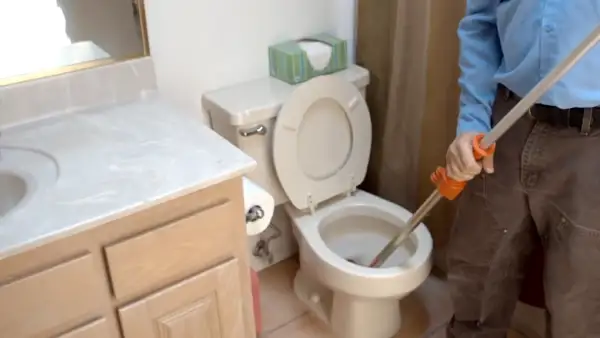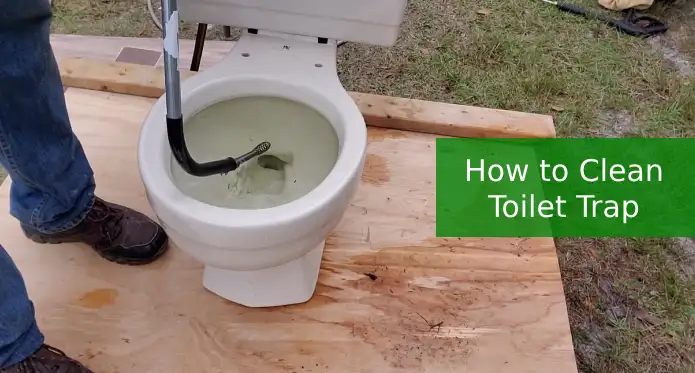Last Updated on October 17, 2023
It’s common to encounter clogs in the toilet trap, leading to frustration and inconvenience. These clogs can be caused by various factors, such as flushing non-disposable items, accidental drops of plastic or metal items, or accumulating debris over time.
The question is how to clean toilet traps without contacting a plumber. To clean a toilet trap, you can use either a plunger or a toilet auger, requiring proper technique and care to avoid damage.
For plunger cleaning, first shut off the water supply before plunging. During auger cleaning, you should slowly rotate and push it downward until it’s completely down the drain.
Here, we’ll walk you through methods with step-by-step instructions to clean your toilet trap effectively. From simple household remedies to advanced techniques, we have all the knowledge you need to tackle this pesky problem head-on.
Best Methods on How Do You Clean Toilet Trap

For clearing a clog in your toilet trap, you can try two effective methods.
Method 01: Clearing a clog with a plunger
- Step 01: Prepare
- Step 02: Position the plunger
- Step 03: Plunge
- Step 04: Repeat as needed
Method 02: Clearing a clog with a toilet auger
- Step 01: Set up the auger
- Step 02: Insert the auger tube
- Step 03: Extend the cable
- Step 04: Repeat the process
Here is a breakdown of each method.
Method 01: Clearing a Clog With a Plunger
Follow these four simple steps to clear a clog in your toilet trap using a plunger.
Step 01: Prepare
Ensure there’s enough water in the toilet bowl to cover the plunger cup to create a proper seal. The water level should be sufficient to submerge the plunger cup, allowing maximum pressure and suction.
Step 02: Position the Plunger
Angle the plunger inside the toilet bowl to allow the cup to fill with water while creating a strong seal over the hole.
To achieve this, position the plunger at an angle and press it firmly against the bottom of the bowl. Ensure there are no air gaps between the plunger and the bowl’s surface for maximum effectiveness.
Step 03: Plunge
After positioning the plunger, vigorously pump it in and out of the bowl to create a push-pull effect that can help clear the clog. You can also move the plunger in a circular motion to help break up any blockages.
Doing this creates pressure and suction within the drain, which can effectively loosen and dislodge any blockages.
Step 04: Repeat as Needed
If the clog persists despite your efforts, keep going. Simply repeat the plunging process as needed. Sometimes, it takes a few tries to dislodge and clear the blockage fully. Be patient and persistent in your approach.
But, if the stubborn clog remains after ten attempts, it may be time to consider using a toilet auger for more effective results.
Method 02: Clearing a Clog With a Toilet Auger
Follow four simple steps to clear a clog using a toilet auger.
Step 01: Set up the Auger
Ensure you’ve pulled out the auger handle to expose the cable tip before inserting it into the toilet trap. By exposing only the tip, you can easily guide it through the bends and curves of the trap, effectively reaching and dislodging any clogs. For optimal results, maintain a firm grip on the handle.
Step 02: Insert the Auger Tube
Once you’ve set up the auger, carefully insert the end of the auger tube into the hole of the toilet bowl to access the clogged area. Make sure to push it in as far as possible to reach the trap where most clogs occur.
Step 03: Extend the Cable
Crank and push the cable into the pipe as far as possible, ensuring you reach any bends or obstructions. Slowly push down on the handle while simultaneously turning it clockwise. This motion helps navigate through any tricky bends or blockages in the pipe.
Keep cranking and pushing until you can’t extend the cable any further. This will ensure you effectively clean out the toilet trap and clear any clogs.
Step 04: Repeat the Process
Next, guide the cable back through the tube, moving it left and right to cover the full span of the plumbing system. By doing this, you will ensure that all obstructions have been removed.
Additional Methods for Clearing a Toilet Trap
You can try a few additional methods if you still have trouble clearing a clogged toilet trap.
No 01: Lubricate With Dish Soap and Water
To help clear the clog, add approximately ½ cup of dish soap to the toilet bowl and let it sit for about 10 minutes. Dish soap effectively breaks down the clog and lubricates the trap, making it easier to clear when you flush.
The soap’s slippery texture helps to loosen any debris causing the blockage. After allowing the soap to work magic, simply flush the toilet and observe if the clog has been alleviated.
No 02: Baking Soda and Vinegar Solution
You can easily create a baking soda and vinegar solution to help break down the clog in your toilet.
- Start by filling the toilet bowl halfway with water, making sure not to overflow it.
- Next, add approximately 1 cup of baking soda to the water.
- Slowly pour 1 cup of white or apple cider vinegar into the bowl, being careful not to splash.
- Allow this mixture to sit for about 20 minutes, allowing it to work its magic on the clog. The chemical reaction between the baking soda and vinegar will help break down any blockages in the trap.
- Once the clog is cleared, flush the toilet again.
No 03: Chemical Drain Cleaners (Use With Caution)
When using chemical drain cleaners, always remember that they should be used cautiously due to the potential for damage to plumbing pipes if overused. Wear eye protection and gloves when cleaning with these chemicals, as they can be harmful if they come into contact with your skin or eyes.
These cleaners contain powerful chemicals that can dissolve clogs and clear drains effectively. Pour some cleaners into the toilet and wait for it to work.
Remember, they can corrode and weaken your pipes if used excessively or excessively. The chemicals in these drain cleaners are designed to break down organic matter such as hair, grease, and food particles. They work by generating heat and releasing gasses that help dislodge the clog.
Can a toilet trap clog affect other plumbing fixtures in my home?

A clogged toilet trap can potentially impact other plumbing fixtures in your home, causing drainage issues and backups.
When the toilet trap becomes blocked, it restricts wastewater flow within the plumbing system. As a result, water from sinks, showers, or bathtubs that share the same drainage line may struggle to drain properly. This can lead to backups and unpleasant situations where water backs up into those fixtures.
It is important to address this issue promptly by clearing the clog in the toilet trap. Doing so prevents further complications and ensures all your plumbing fixtures function properly.
Eliminate Toilet Troubles: Clean Your Drain Trap
Cleaning the toilet trap is an essential task that should be done regularly to maintain the proper plumbing system functioning. Following the methods mentioned in this article, you can effectively remove any blockages or buildup in the trap.
Also, it is important to remember that a clogged toilet trap can affect your home’s plumbing, leading to further issues. So, take the necessary steps to keep your toilet trap clean and ensure a smooth flow of waste.


